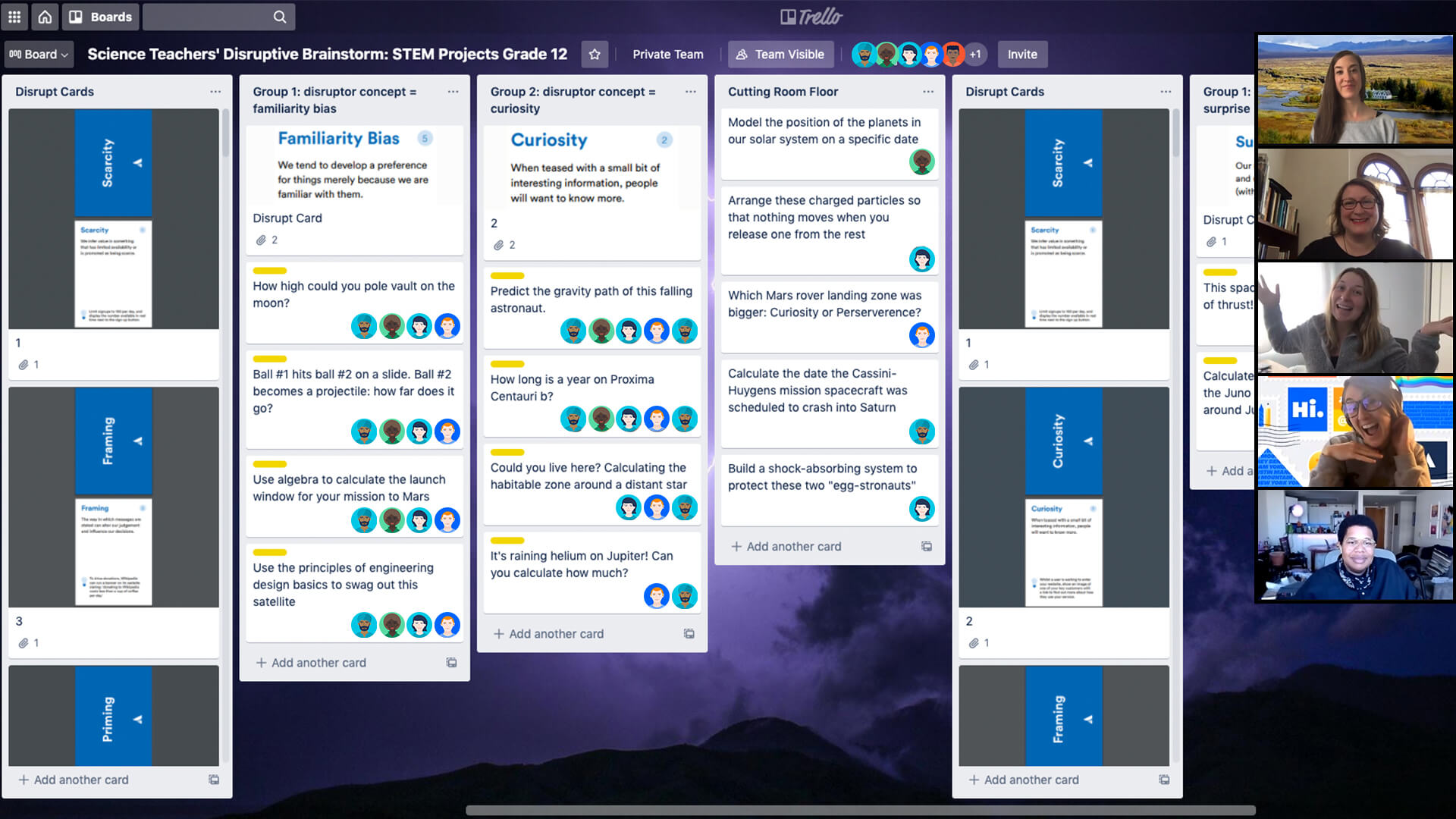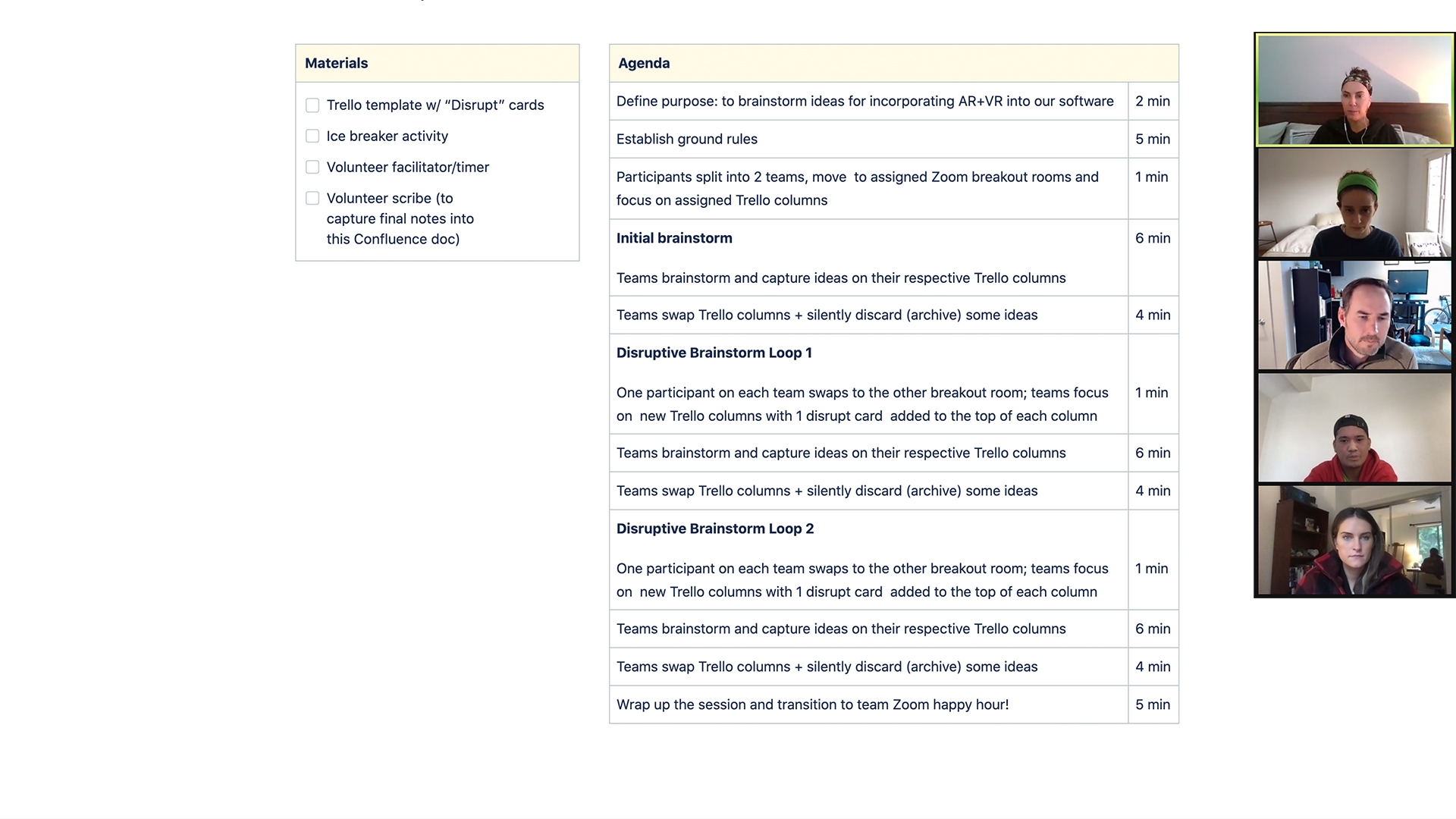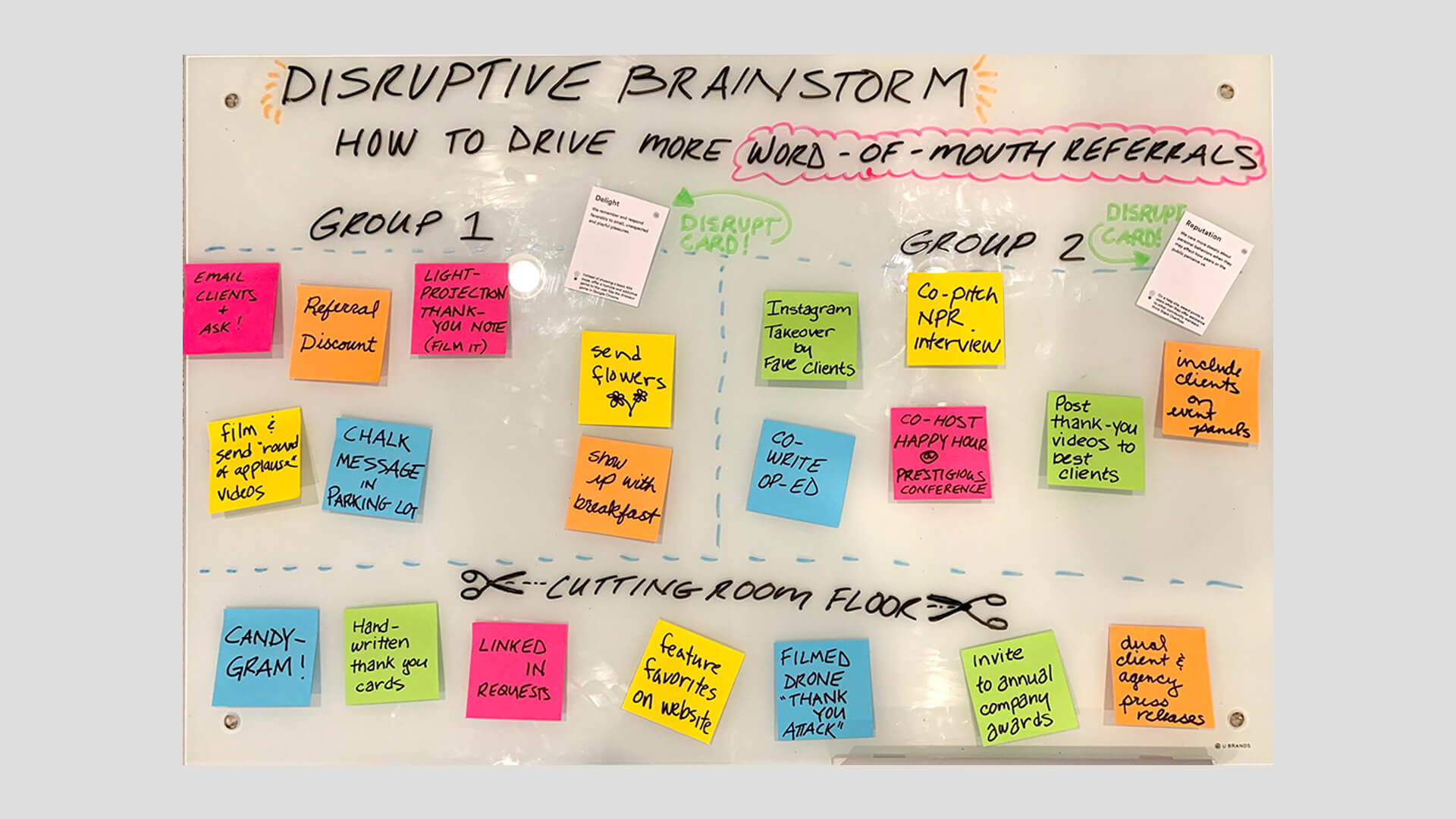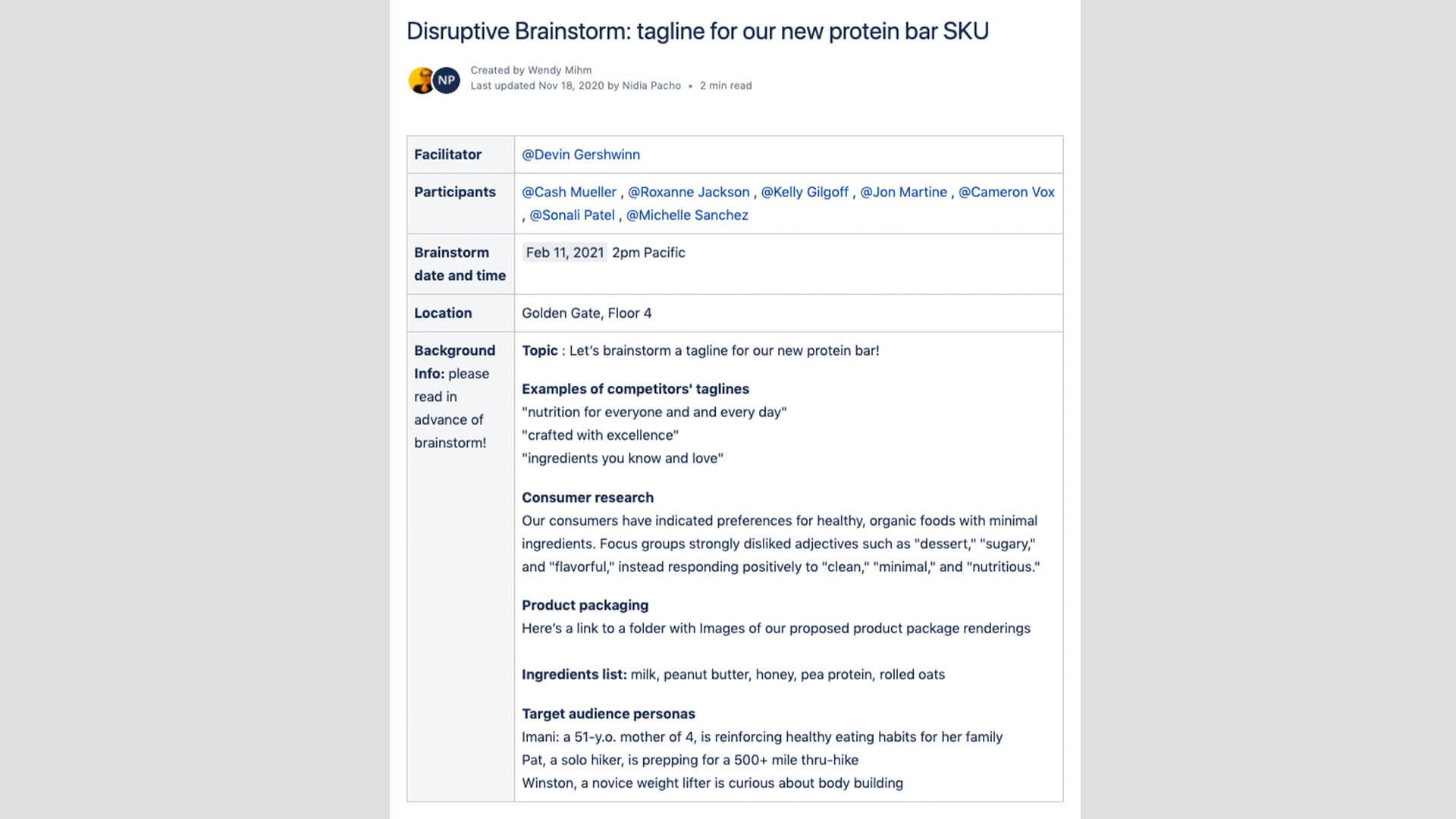Disruptive Brainstorming in action
Science teachers brainstorm new STEM project ideas for high school students.
A team of software developers use Confluence to prep for their disruptive brainstorming session.
An ad agency team brainstorms ideas for driving more word-of-mouth referrals.
What you'll need
Remote
Video conferencing with screen sharing
Digital collaboration tool (see templates)
Timer
Optional templates
Atlassian Templates
Instructions for running this Play
1. Prep 15 MIN
First, define a theme for your brainstorming session. Your theme can be broad or narrow — any problem that needs solving or process that needs improving is fair game. Just make sure to state your theme precisely so everyone understands what they’ll brainstorm about.
Next, prepare your materials. Remote teams — especially those who operate asynchronously — should create a collaboration document, like a Trello board or Confluence page. You can use the templates provided at the top of this page, if you’d like, or create one of your own. You’ll also need to download the Disrupt cards and have them ready to screen share.
In-person teams should find a whiteboard or large paper and set out sticky notes and markers in a meeting room. Print out the Disrupt cards and bring them with you.
Finally, create a document with all the relevant research and background on your theme. Share it with the team a couple of days in advance so they can start thinking about the topic. You can include details like competitor and consumer research, design mockups, buyer personas, color palettes — anything you think might be helpful to the team.
TIP: CHOOSE A TOPIC
Is there a problem the team can solve? A process that can be refined? Is there something frustrating customers?
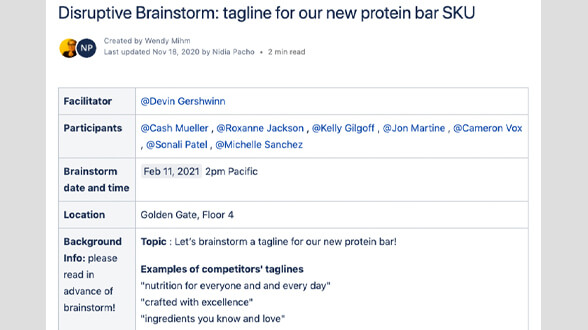
EXAMPLE: BACKGROUND INFO
Marketers capture background information in Confluence for their upcoming Disruptive Brainstorm.
2. Set the stage 5 MIN
At the beginning of the meeting, let the team know the following:
- The team is here to produce as many ideas as possible. You want quantity — quality will come later.
- It’s crucial to keep an open mind and remember everyone’s ideas are valid.
- The goal of the meeting is to generate, not to judge. In the end, there will be a few good ideas for the team to take action on. Trust the process!
3. Brainstorm 10 MIN
The team should break into two groups to do several rounds of brainstorming. Use the video conferencing software’s breakout rooms functionality for remote or hybrid meetings.
Set a timer for 10 minutes, and start the brainstorm session. Come up with as many ideas as possible. Remember, nothing is off the table—you're going for maximum quantity.
Have team members add ideas one at a time to the template, whiteboard, or sticky notes. Discuss each idea with the group as the team member adds it to see if anyone has anything to add or refine.
4. Cut! 5 MIN
Bring the groups back together.
In silence, have each group remove ideas from the opposite group’s board. Remove ideas that you won’t be able to achieve, won’t have support, or don’t relate to the brainstorming theme. Generous trimming is important to make room for new ideas. Remember, no discussion during this phase.
TIP: QUIET, PLEASE
Discussing what team members remove stops the creative flow and moves into judgment. Keep creativity alive by keeping quiet.
TIP: CUTTING ROOM FLOOR
Avoid revisiting vetoed ideas during the session to keep the creative momentum.
5. Disrupt 5 MIN
Now comes the fun part: switch one member from each group to the opposite side to shake up everyone’s thinking. Then, have each group pick a number at random from one to 33 — their number will correspond to a Disrupt card. Groups will use the card to guide the next round of ideas.
TIP: A NEW ANGLE
Disrupt cards constrain brainstorming and force the team to look at the challenge from a different perspective.
6. Brainstorm again 10 MIN
With the new team member and Disrupt card, separate the groups again, set a timer for 10 minutes, and begin a new round of brainstorming. This time, the ideas should relate to the concept on the Disrupt card.
7. Cut! again 5 MIN
Once again, bring the groups together and have each group remove ideas from the opposite brainstorm list. Do so quietly and without discussion.
8. Final round 10 MIN
Have a different person from each group switch sides and choose a new Disrupt card for each team at random.
Set a timer for 10 minutes and brainstorm one final time.
9. Final cut 5 MIN
Bring both groups together for the final cut. Make it the most significant cut yet, even if (or especially if) it means only one or two ideas are left per team. Your final ideas must be worth pursuing.
Follow-up
Action
After the final cut, gather the ideas you have left. Assign each idea an owner who will investigate how to make the idea a reality. Make a list of what the team needs to know to get the idea off the ground, and include a timeline for when the owner should be ready to discuss their findings with the team.
Document
Post the collaboration document or sticky notes from the brainstorming session in a space where the whole team can see and refer to it as needed.
If your team uses Jira, add action items from the brainstorming session as ideas to your team’s Jira project.
Variations
Scramble
Instead of swapping just one team member between rounds, scramble the breakout rooms (for remote teams) or assign new teams randomly (for in-person teams).
Super cuts
At the start of each round of cuts, specify how many ideas each group can leave on the board at the end of the round. Try two to three ideas for a challenge or one for advanced mode.
Envelope, please
For a remote session, pre-select Disrupt cards and add the information from each one to a collaborative spreadsheet for each group. Use the fill tool to obscure the details, and have the group “uncover” a card each time by removing the fill.
For in-person Plays, pre-select Disrupt cards and place them in envelopes at each group’s space. Open a new envelope each round.
Pre-selecting the cards can help guide the sessions in a particular direction, or at the very least, avoid cards that you know won’t be on theme. Pre-selecting can also help play to a particular team’s strengths and weaknesses.
Explore other Plays
Stay up to date
Get the latest Plays and work life advice when you sign up for our newsletter.


